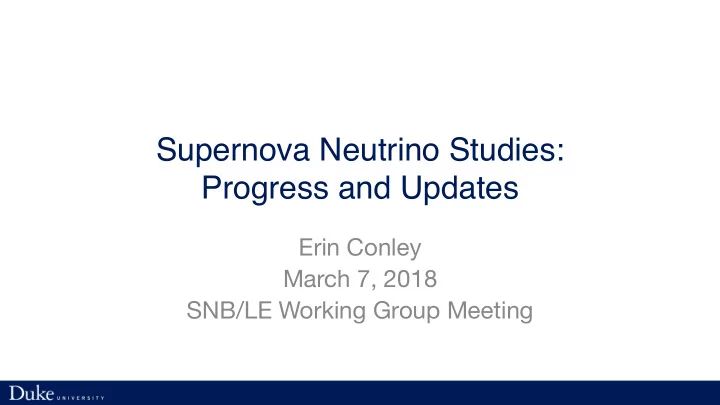

Supernova Neutrino Studies: Progress and Updates Erin Conley March 7, 2018 SNB/LE Working Group Meeting
Outline Position resolution study • – Introduction – Position difference – Position resolution – Event display study MARLEY smearing matrix • – Introduction – Steven Gardiner’s fractional energy plot – The behavior of the fractional energy plot Summary • 2
Position Resolution Study: Introduction • Determine position resolution for low-energy neutrino events – Difference between truth, reconstructed positions (2D and 3D) – Optical flash provides the timing information – If difference ~ 0, then we have good resolution! • Motivation – If resolution is bad/not optimized, then significant information about neutrinos will be lost – Calibration requirements – Rejection of background – Correction for drift in z direction 3
Position Difference • Reconstruction algorithm used: pmtracktc • Two methods with consistent results: – First hit in first track • Advantage: closer to raw data! – First TrajectoryPoint object in first track • Advantage: 3D information! • Found “x” position using these methods, took difference from MC truth vertex – Width of position difference distribution = resolution 4
Position Difference Plots First TrajectoryPoint First Hit 80.25 MeV neutrinos; 1000 events (3 events had no track info); x position only Sharp central Gaussian + wider Gaussian present at all energies 3/7/18 5
Fitting with two Gaussians • Had ROOT fit position difference (in x) distributions on two different ranges • Central peak: [-4.0, 4.0] • Wider dist.: [-50.0, 50.0] • Plotted widths/resolutions against one another Example plot: 30.25 MeV, 1000 events Blue: Fit on [-4.0, 4.0] Red: Fit on [-50.0, 50.0] 3/7/18 6
7 80.25 MeV neutrinos; 1000 events (3 events had no track info); x position only
Position Resolution Plots Central Peak Resolution Wide Peak Resolution 80.25 MeV neutrinos; 1000 events (3 events had no track info); x position only 3/7/18 8
3D “position resolution” Use TrajectoryPoints in • first track Find the distance • between 3D TrajectoryPoint, MC Truth vertex “Position resolution” • determined by finding distance in which 68% of the events are contained (example right) 9
10
Event Display Study As neutrino energy increases, two separate distributions • visible in the 3D distance distributions Second distribution doesn’t seem to appear for lower • energies, i.e., lower energies just have a sharp peak + tail – Not a lot of charge deposited → not enough reconstruction information for 2+ tracks – Tracks small at lower energies → front/end of track less important Significant issues uncovered in study; need to combat • – Determining the front/end of reconstructed track matters – Sometimes the first track is not the primary electron track 11
Current Work • Determining which track most likely reconstructed primary electron – Likelihood function using track/hit information – Machine learning? • Determining front/end of track – My current function to determine front/end agrees with truth ~75% of the time (40%-60% performance for energies lower than 13-14 MeV) – Looked into ResidualRange information; only agreed ~40% of the time with truth 12
MARLEY Smearing Matrix Checks: Introduction Summer 2017: Worked to • update default LAr smearing matrix in SNOwGLoBES using MARLEY simulations As neutrino energy increases, • one might expect number of nucleons (neutrons) to increase; more energy becomes dedicated to nucleons Checked that smearing matrix • agrees with simulation in primary MC truth study Average fractional truth energy • vs. neutrino energy plot 3/7/18 13
Current Work • Smearing matrix with no neutrons – Currently simulating 10k ν e CC events from 4.25 MeV to 99.75 MeV in 0.5 MeV increments – Use simulations to reproduce plots from primary truth study, compare behavior to previous study • Steven Gardiner and I discussed MARLEY smearing matrix checks – Steven reproduced fractional energy plot – Primary truth study consistent with MARLEY physics – Model not as reliable at 60+ MeV ν e energies vs. > 60 MeV 14
Steven G.’s reproduced fractional energy plot 15
Comparing the two fractional energy plots Steven G’s plot My plot 3/7/18 16
High-lying nuclear levels become accessible. More Neutron emission phase space becomes possible. These becomes available events bring the gamma for nucleon No more nuclear matrix elements De-excitation gammas fraction down as the emission. available in model; all excess energy from nucleus dominate; neutron takes away most given to primary electron not enough energy to of the available energy. excite higher levels 17
Summary • Initiated study to determine the position resolution of low-energy neutrino interactions – Looked at both 2D and 3D position resolutions – Secondary distributions in the position difference distributions most likely due to reconstruction issues • Steven Gardiner reproduced the primary fractional energy plot with similar behavior to mine – We believe it agrees with the model currently implemented in MARLEY – Updating the model would help with energies > 60 MeV 18
Backup Slides
Event Display Study: Introduction • Looked at event displays in three (approximate, eye- balled) ranges: – Large peak close to zero – Second smaller distribution (if applicable) – Outliers in the tail • Did this for 5.25 MeV, 28.75 MeV, 95.25 MeV neutrino energies 20
28.75 MeV – Zoomed In [0, 50.0] Entire distribution is [0, 400.0]; Two distributions visibly seen (wider second distribution); long tail after the two distributions 21
28.75 MeV – Zoomed In [0, 50.0] First track reconstructs primary electron well Significant portion due to incorrect front/end of reconstructed track Other issues include unideal reconstruction (e.g., only half the track was reconstructed); a secondary track Significant portion due to reconstructed the primary electron secondary track reconstructing primary electron 22
Examples of event displays = Reconstructed Track, = Truth vertex Distance: 6.16179 cm; example showing incorrect front/end of Distance: 36.9881 cm; example showing secondary track (Track #1) track; even more significant at higher energies! reconstructing the primary electron 23
Recommend
More recommend